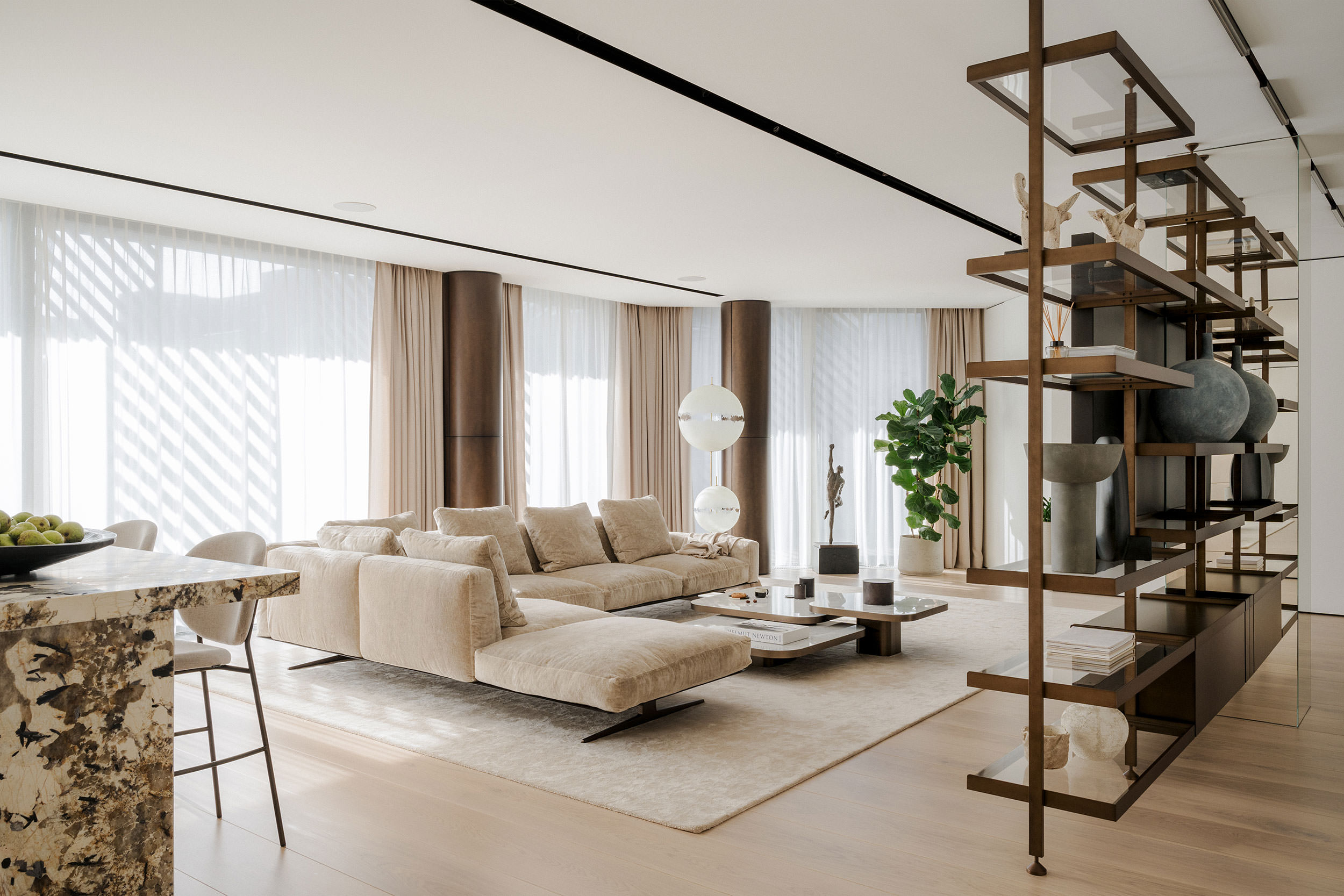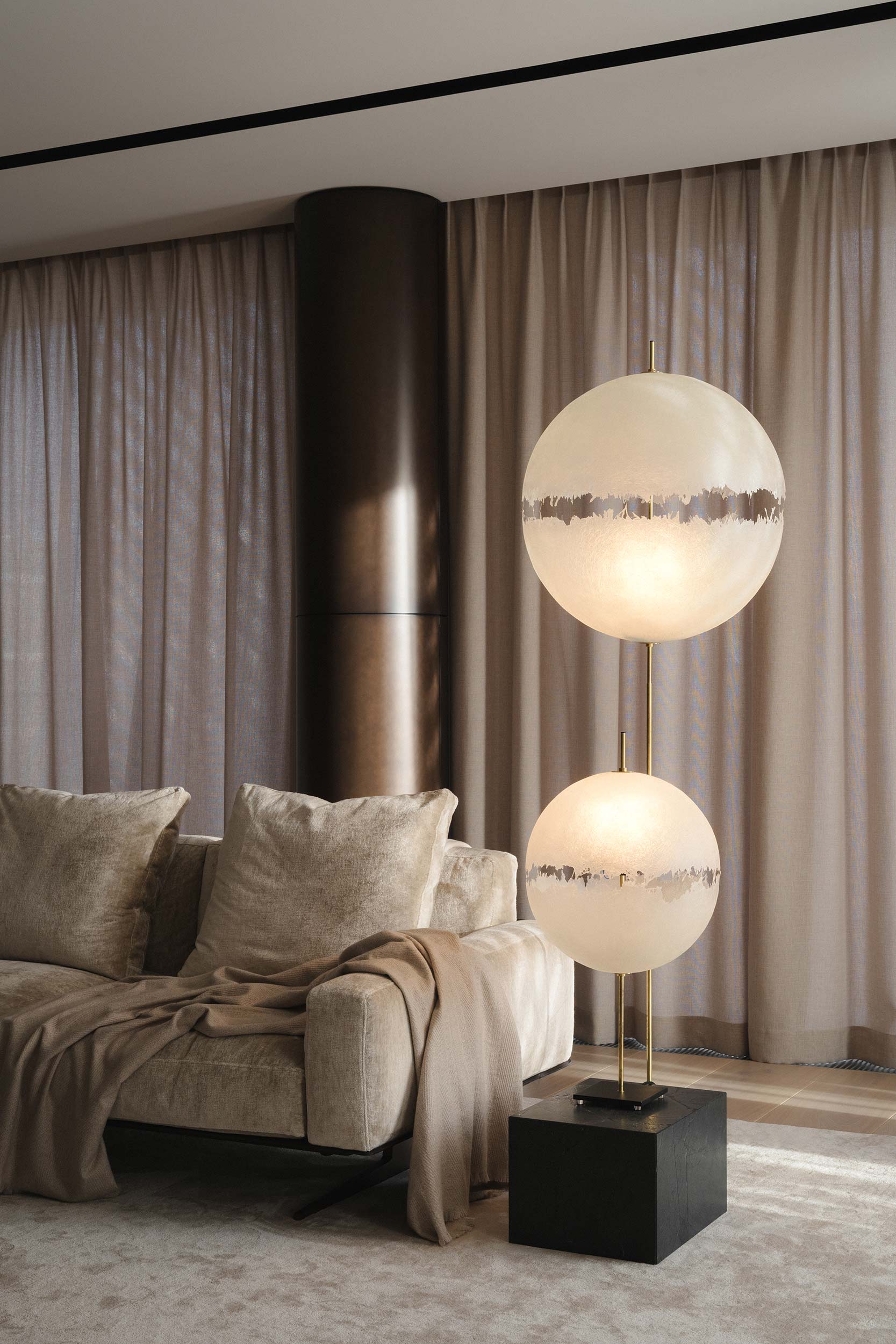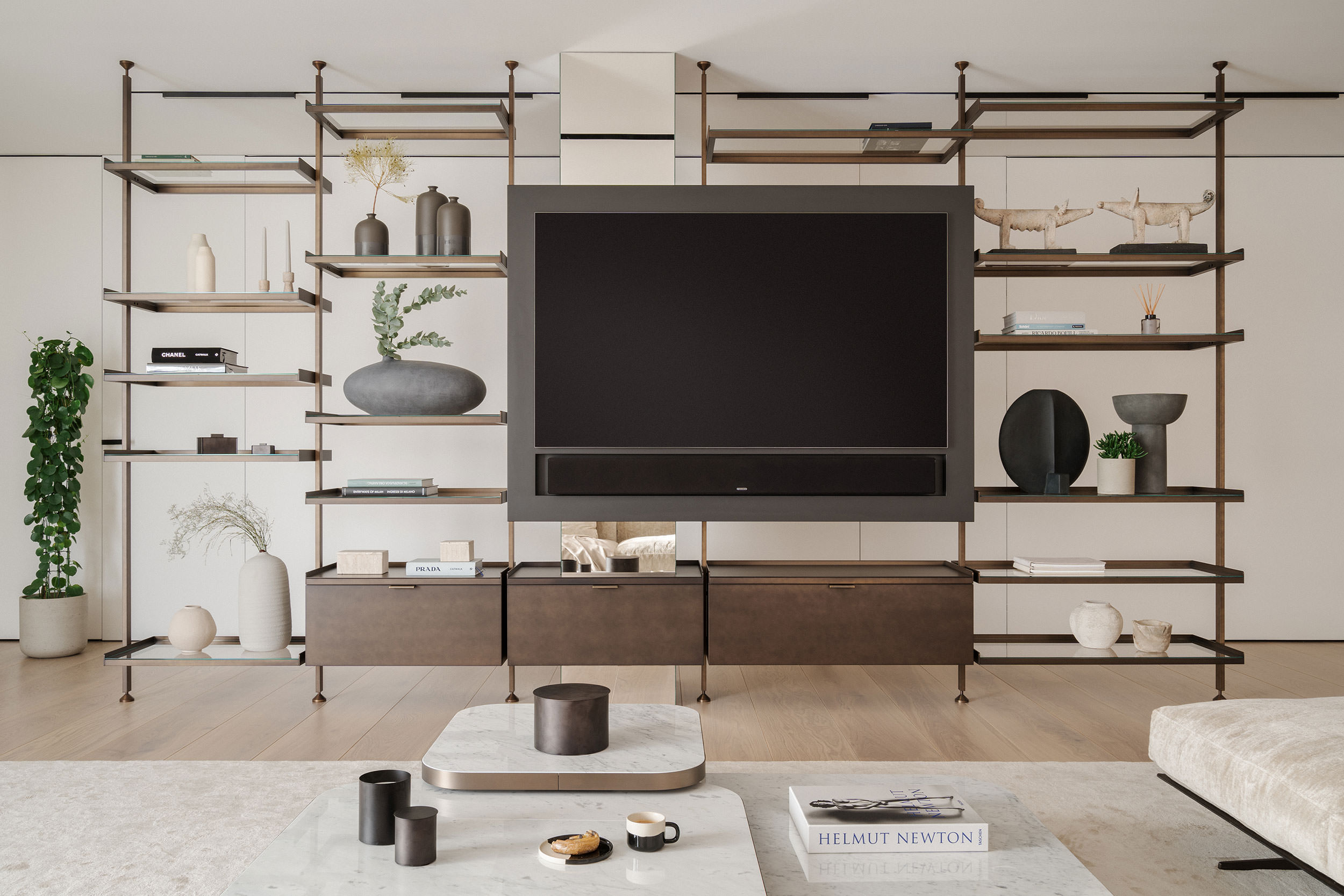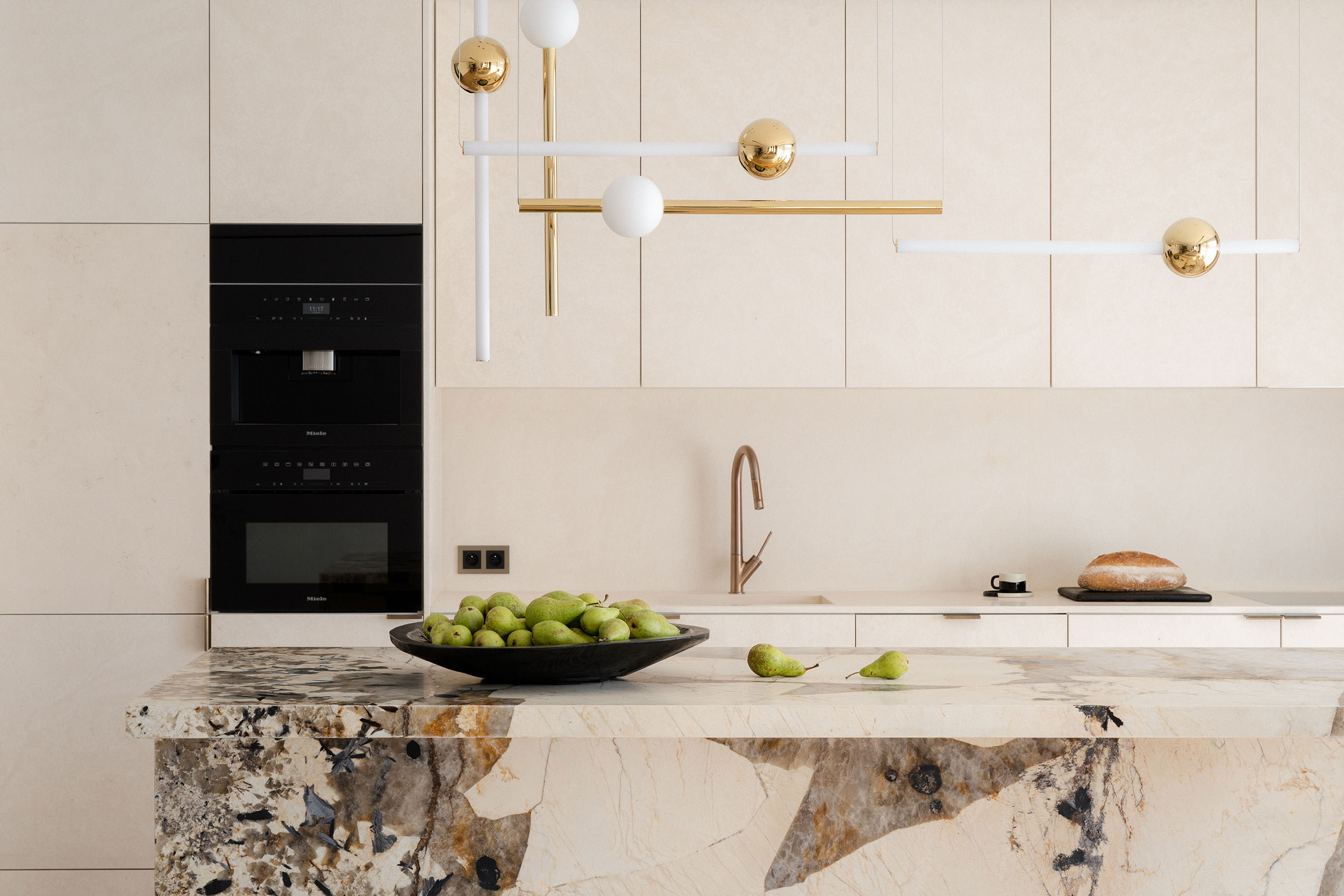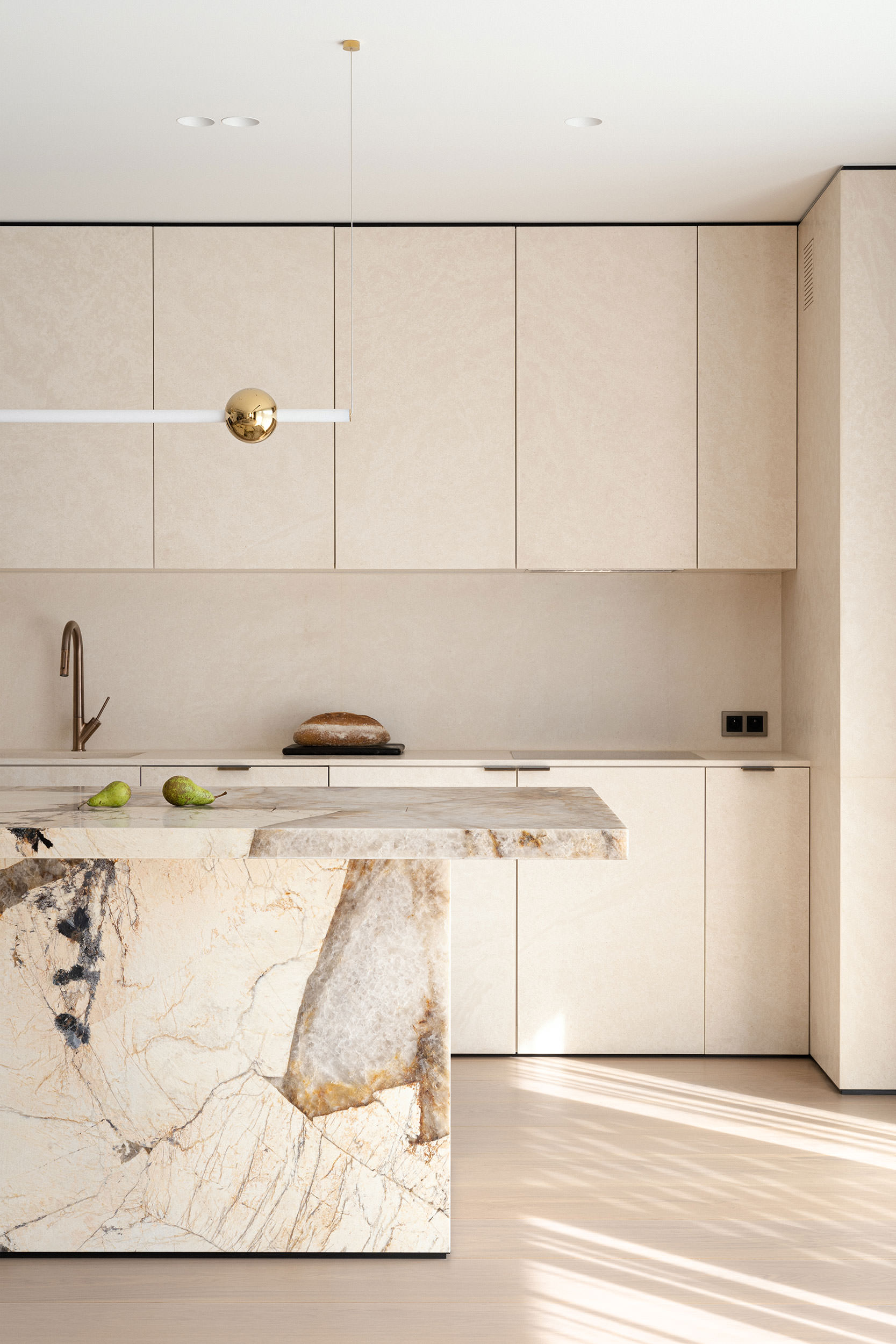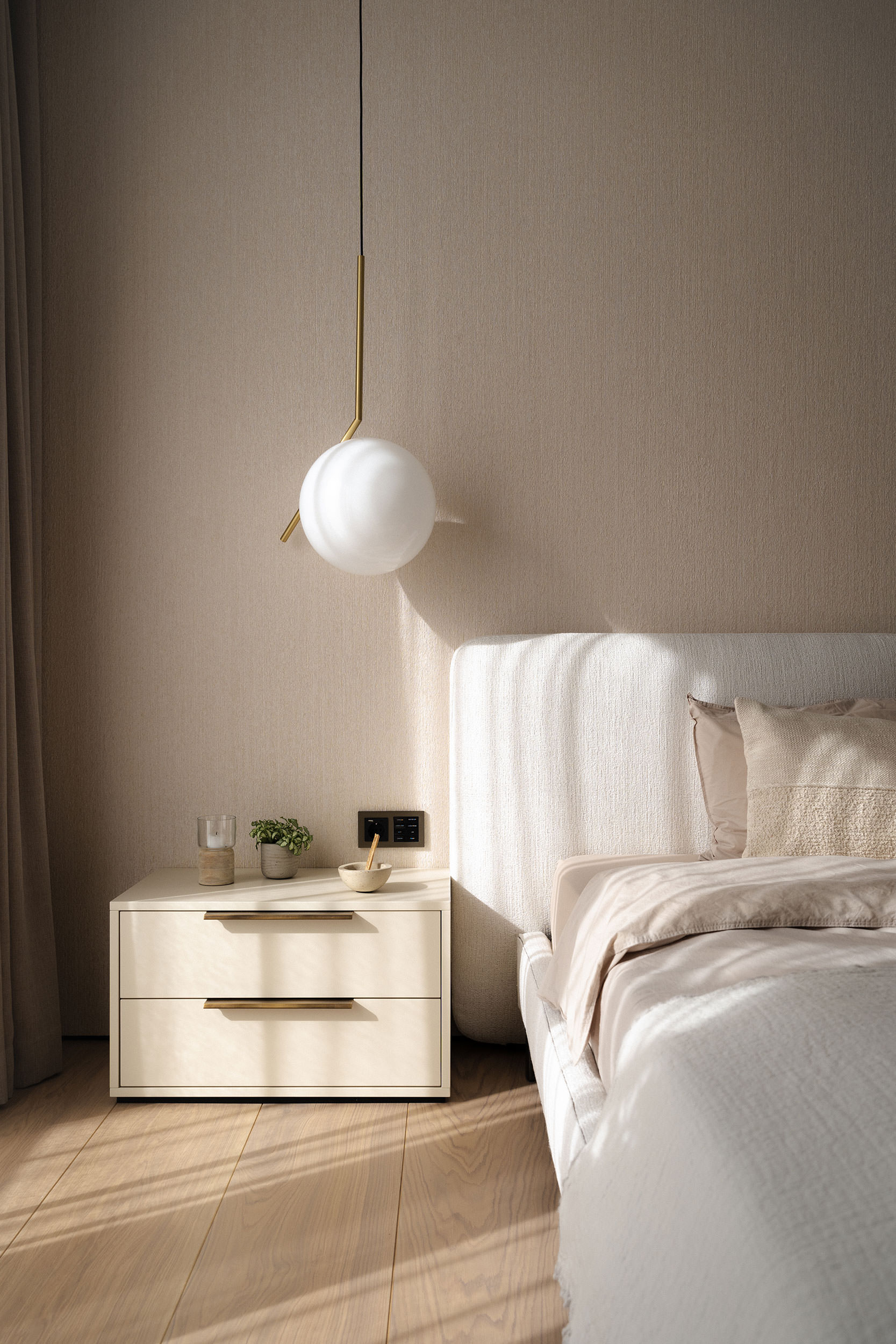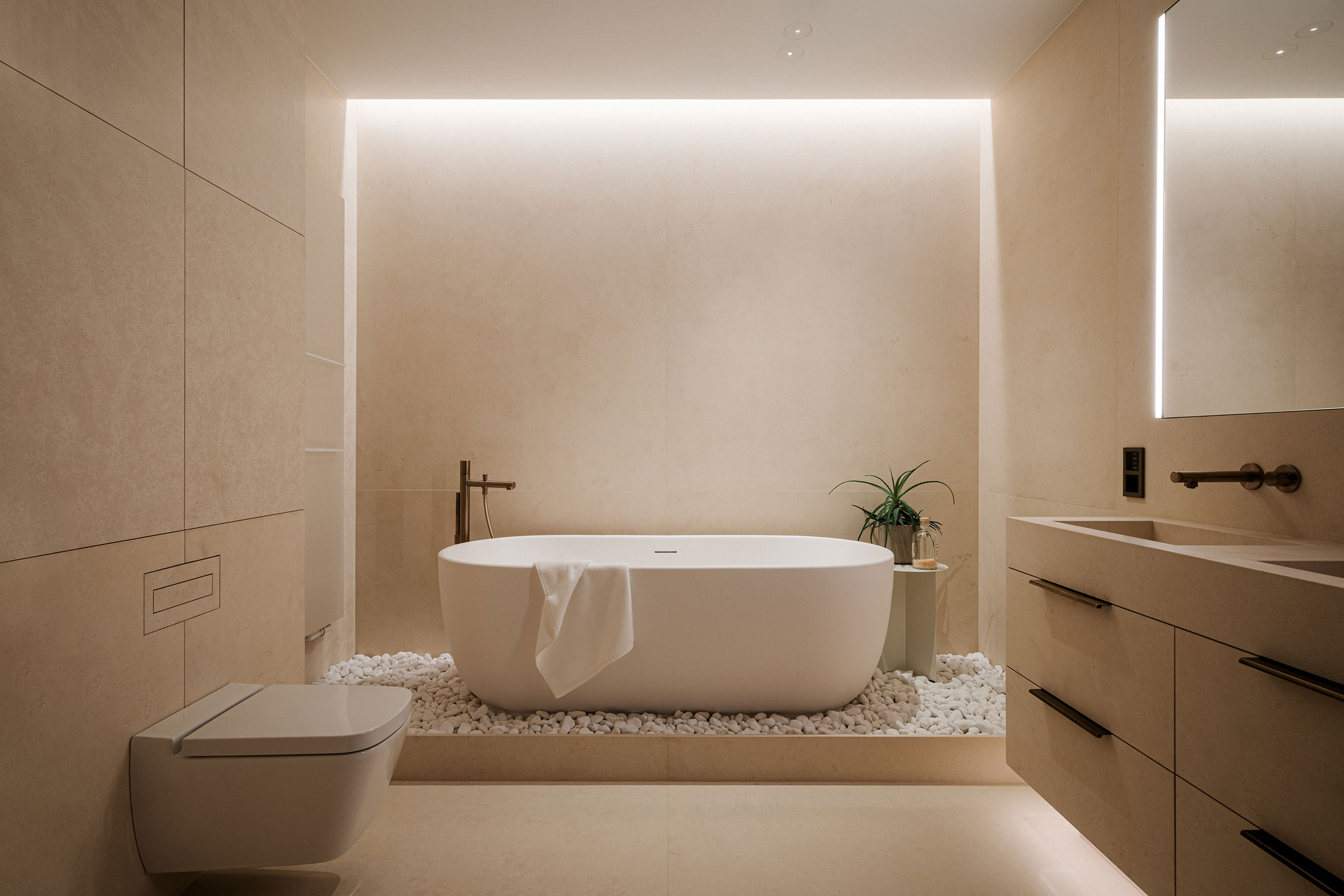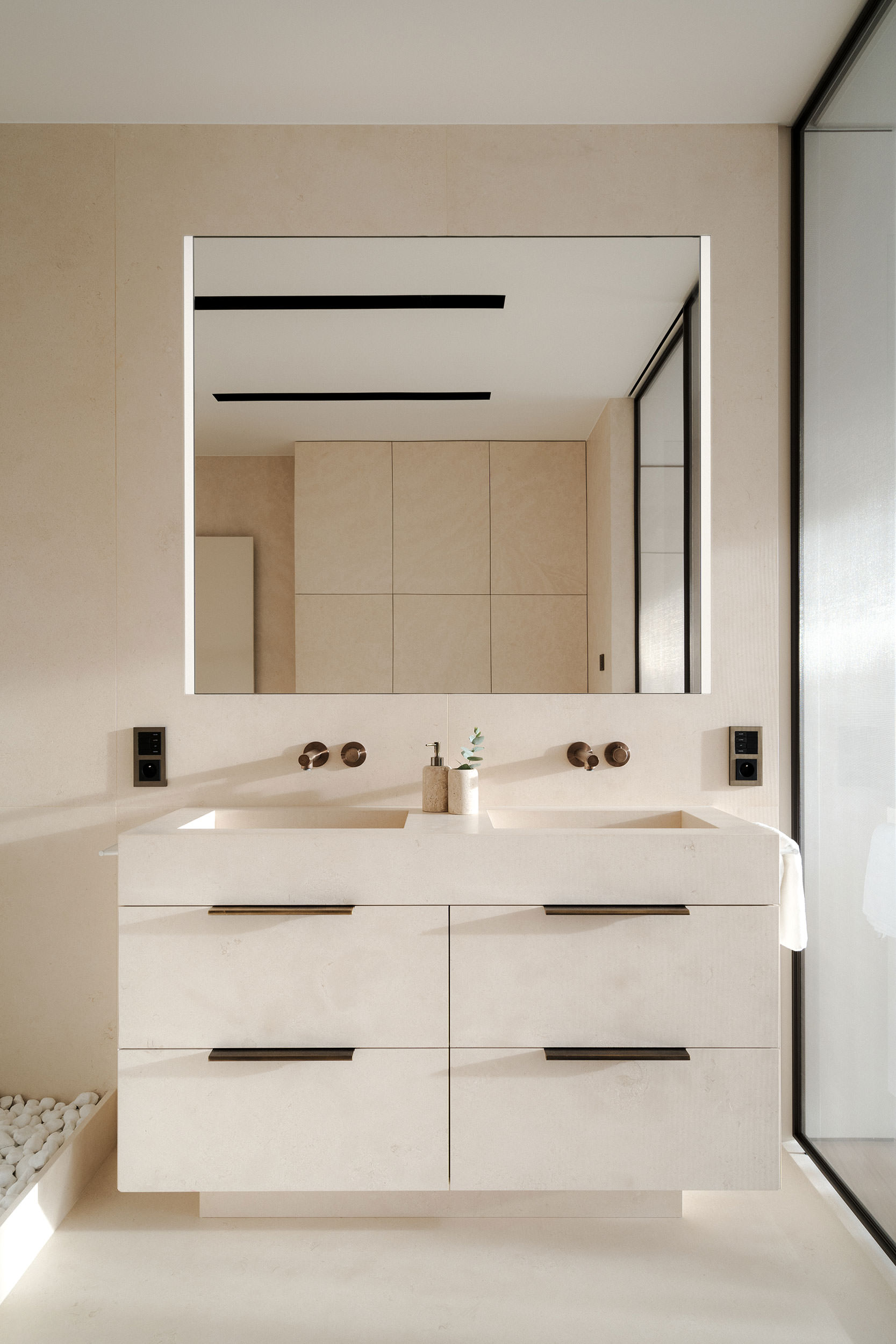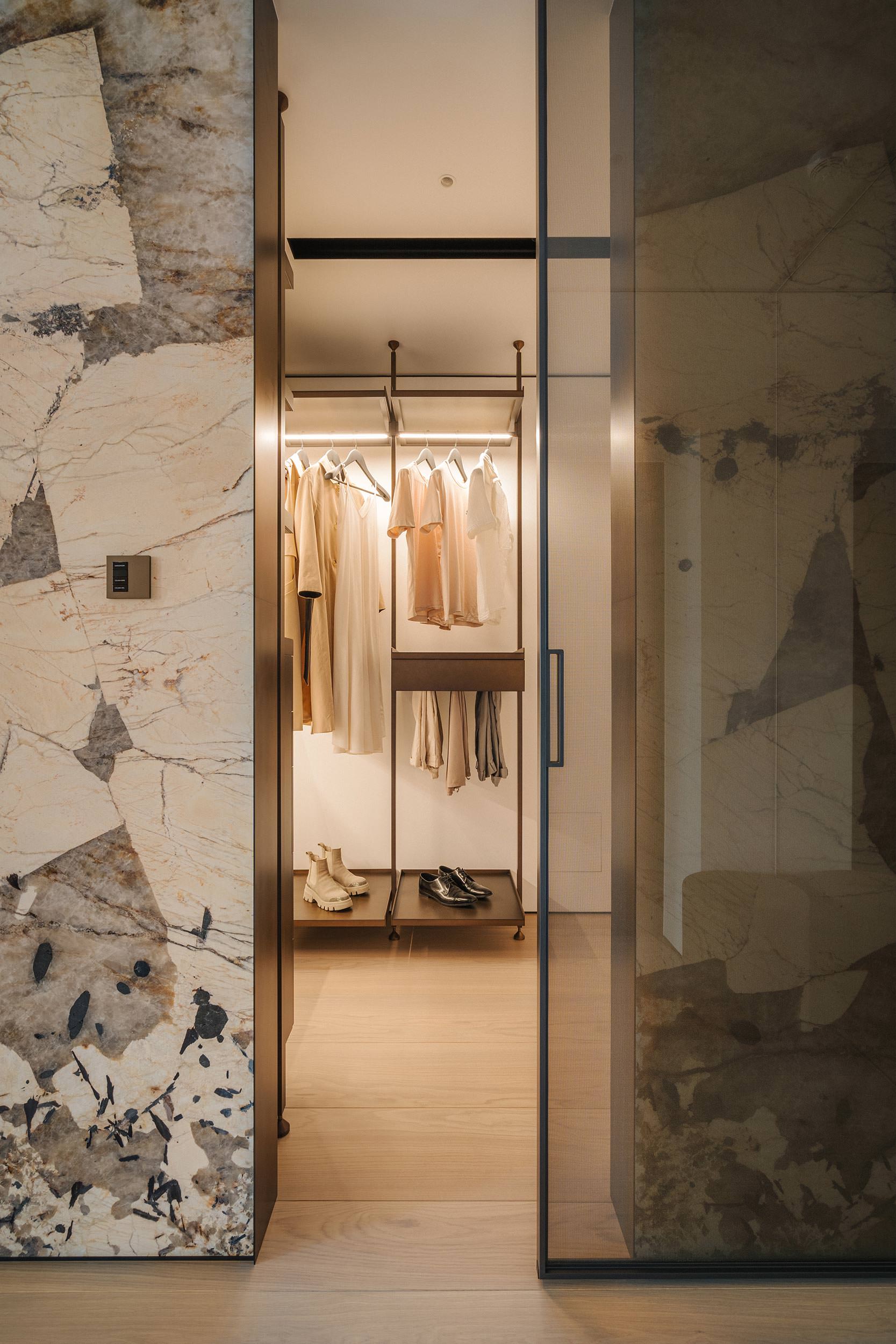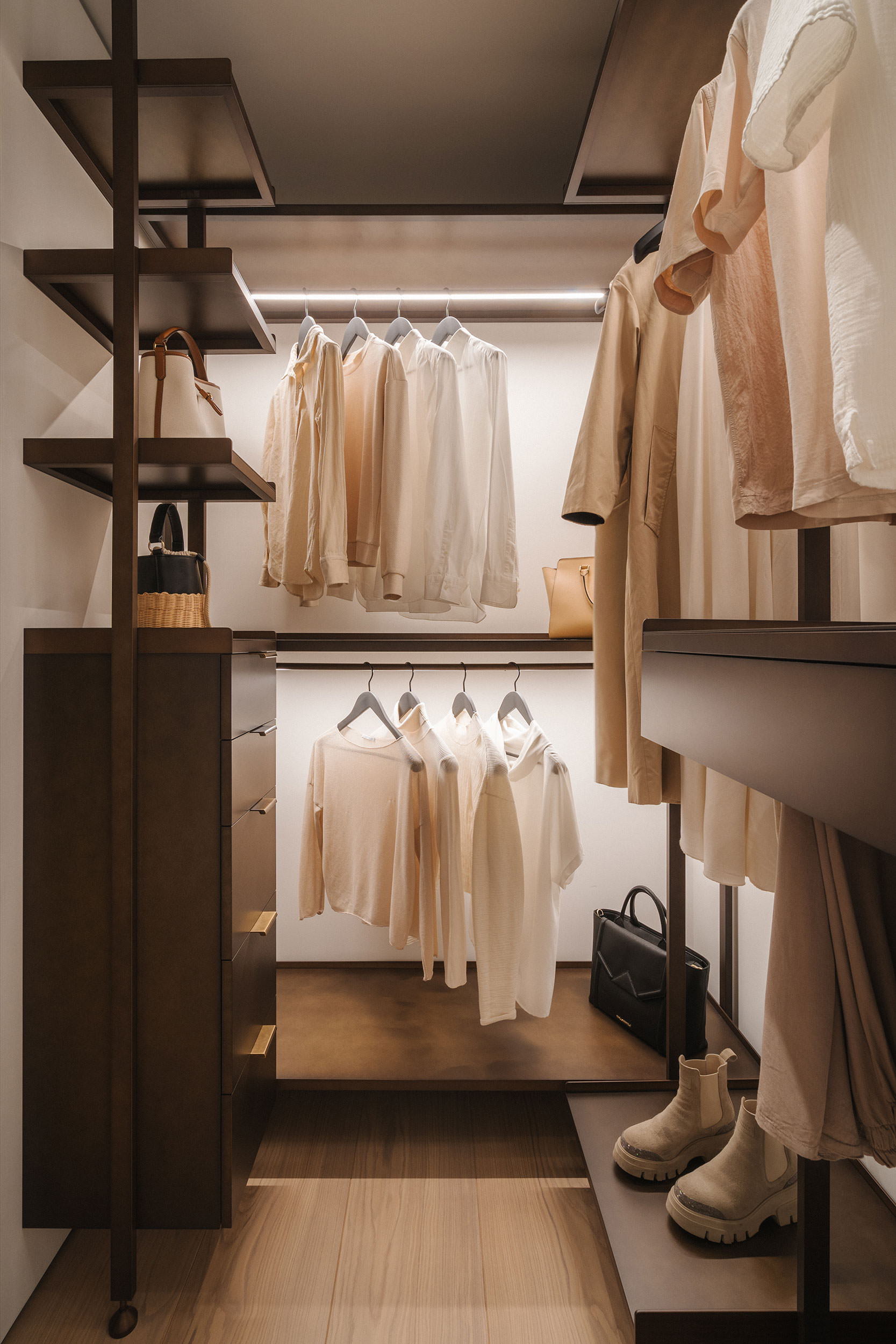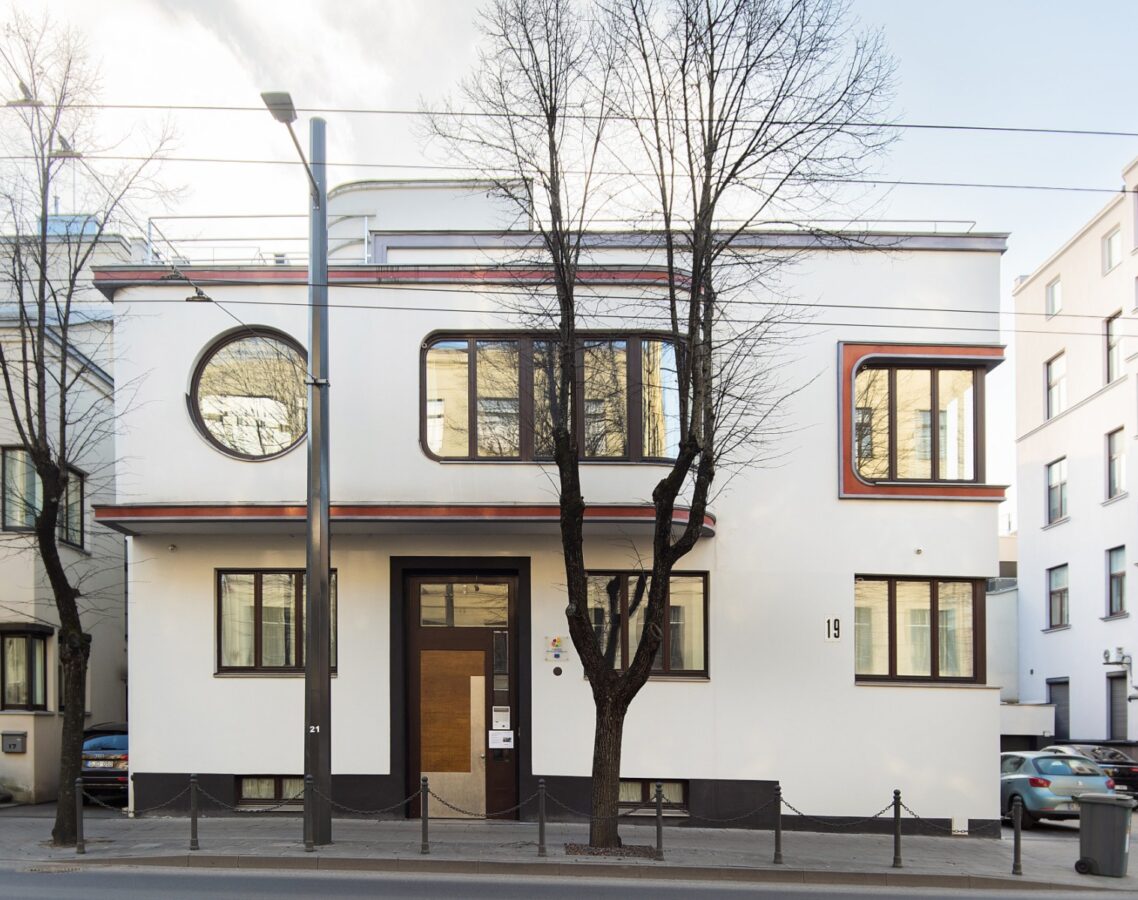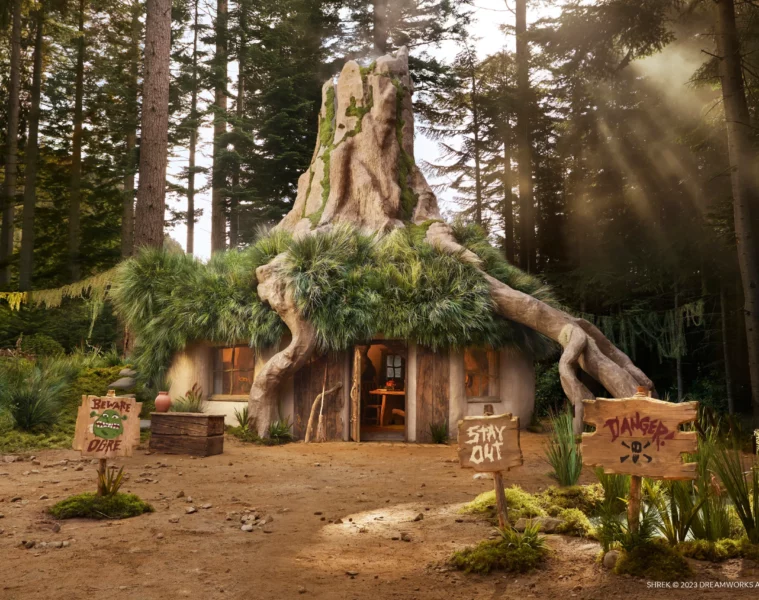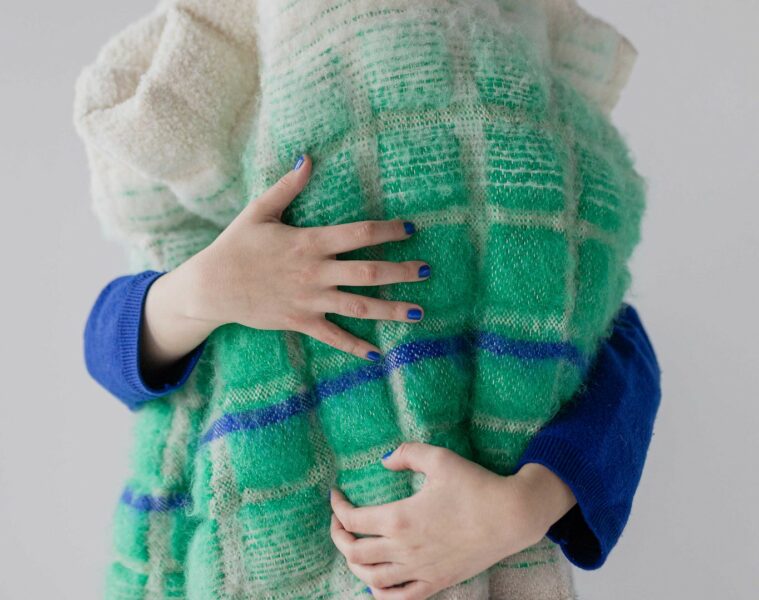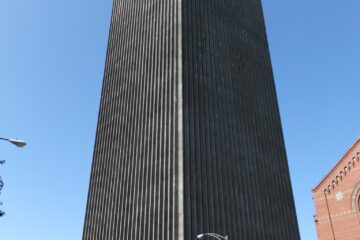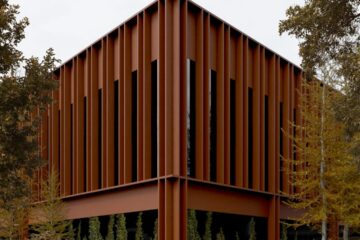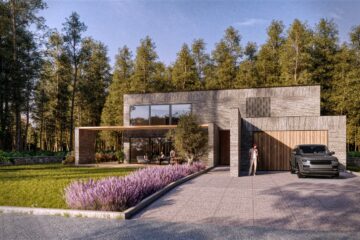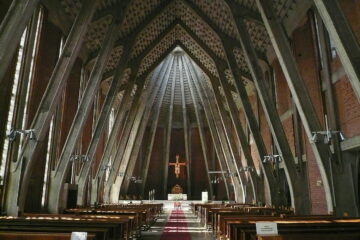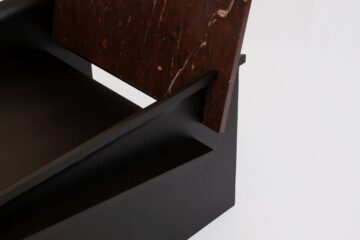Its interior was designed by KANDO Architects. The flat in Warsaw’s Powiśle district is a sizable space that is bright, full of sophisticated accessories and natural materials. The floor is decorated with wood, there is a lot of stone, and their common denominator is nature. After all, man feels best when surrounded by nature. What was the design process like?
They live near Olsztyn on a daily basis and come to Warsaw for business. When their travels became quite frequent and regular, they decided it was time to think about a pied-à-terre – a second home where they could feel at home. The idea was to buy a property in one of the most prestigious locations in the capital – in the trendy Powiśle district close to the centre. The choice fell on a new development – a luxury building with an interesting, modern architecture inspired by the structure of crystal. Here, close to the banks of the Vistula, they chose a 140-square-metre flat and entrusted its finishing and furnishing to the design team at KANDO Architects. “We profess and design a contemporary spatial form refined in detail and filled with natural, noble materials,” the young architects introduce themselves. Such an intro obliges one to do something – and it matched the owner’s vision perfectly, so it’s no wonder he didn’t hesitate in choosing the professionals
Pure nature
– The changes to the interior layout were subtle on our part,” explains Kinga Klietz-Łęska and Karolina Krawczyk – co-owners and chief designers of the studio. – We separated the guest room, gently adjusted some of the walls. However, with this project, the main task we had to carry out was the detailed development of the interior finishing concept, also from the technological side. The owner wanted to use only natural materials. If brass, then solid, like stone, not sinter, carpet made of authentic silk and not just an admixture of it,” they continue
In addition to the undoubted advantages, the architects also presented the owner with the dangers of using 100 per cent natural materials on a daily basis. The client, however, was adamant
– A stain on the carpet or upholstery, a mark left by a glass on the stone were no major concerns for him,” says Tymek Łęski, the third partner, studio manager and coordinator of the project. – Here, on the contrary, the owner was concerned about sterility and the lack of traces of life and memories written on the material. They testify to the naturalness of this place, which will change with time and grow old together with its inhabitants,’ he explained to us further. We were touched by this approach
Brass, silk and art
There are two entrances to the flat. One directly from the lift (this is the one the owners usually enter), the other from the stairwell, for guests, couriers, building staff. Vis-à-vis the entrance, behind a sliding door of smoked glass, a dressing room has been designed, combined with a laundry room. The wardrobes and hangers are made of solid brass patinated in bronze. This material is used throughout the flat. It is used for the furniture handles, the cladding of the structural columns and, above all, for the bookcase in the living room. It is an absolutely sculptural form that undoubtedly catches the eye in a 90 square metre space. – It was custom-made by a locksmith, to size and to our design,” explains Karolina. Of course, it is entirely made of solid brass (except for the glass shelves) patinated in antique bronze. In order to achieve the beautiful effect of noble brass, a special patinating agent was ordered, which had to be imported from as far away as… New Zealand. – At first the client wondered if it was worth the effort and if it wasn’t better to simply make the furniture out of bronze rather than patinate the brass, says the designer. – If it wasn’t for the fact that there were no contractors in Poland who would undertake such a project, he would probably have decided to do it. Price was not an issue. In the end, the effect is spectacular. The shelving unit fitted perfectly into the structural column behind it, which the designers encased in mirrored panels. The result is a delightful sculptural form combining utilitarian and artistic functions. The TV has been discreetly integrated into the furniture, which is suspended from an invisible structure, and audio equipment has been mounted above the sofa. This makes it possible to listen to high-quality music and watch a film in comfort in the living area
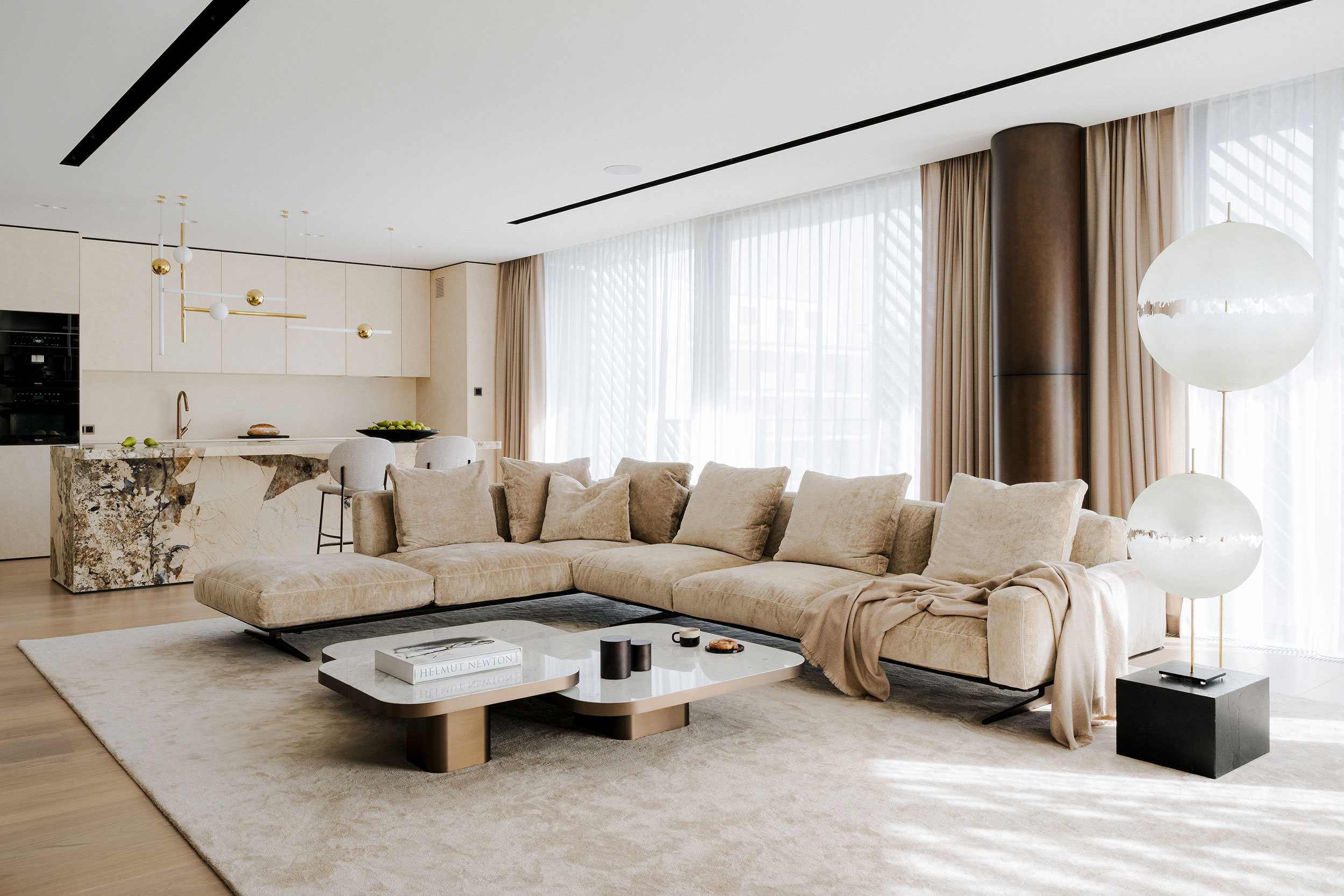
This part of the living room is very important to the owners. They lead active lives on a daily basis – this space was to encourage them to relax and catch their breath after a long day. The architects made an effort to make it truly luxurious. In the centre of this zone, opposite the bookcase, stood a Flexform sofa designed by Italian design legend Antonio Citterio. The minimalist corner sofa with chaise longue function, in light upholstery, played beautifully with the ClassiCon tables by Brazilian designer Guilherme Torres, finished in Bianco Carrara marble and also in brass – oxidised and brushed. The architects composed them in such a way that together they form an interesting geometric form, but the positioning can be changed as required. The seating area is flanked on the side by a jewellery lamp from Catellani & Smith, and from below… and here’s another surprise. The sofa was placed on a pure silk carpet. – Such a carpet, without any additives such as viscose or polyester, is very rare, in fact it doesn’t happen,” says Kinga. The investor was prepared to wait as long as it took, because a fabric of this size and material is not made overnight. This one was hand-woven over a period of nine months at Jacaranda, one of the few companies specialising in custom-made luxury carpets made from natural materials. – The production process was very time-consuming, but also interesting, the architects explain. – First, a month after placing the order, we received five samples in different shades and weaving structures, so that we could perfectly match the final effect of the carpet to the colour and texture of the sofa and the environment in which it was to be placed. In the process, we learned about the unusual process of sourcing yarn from mulberry silkworm cocoons and so on. This was an extremely inspiring and interesting experience for us
There will soon be even more works of human hands like this carpet in this interior. Therefore, the walls have been painted neutral white and gently undercut from below and above. – We deliberately used a shadow-gap solution. Someday, over time, the space will be filled with art. Now the walls are like a painter’s canvas that has been primed and awaits the painter’s gesture. The levitating effect of the wall above the floor will make the attention focus more intensely on the painting – a procedure often used in the best museums or art galleries, Tymek explains
Turkish limestone, Brazilian quartzite
The living room blends seamlessly with the kitchenette and the large island that serves as a dining table. The cooking area was a great challenge and a technological experiment for the architects. As one of the owner’s expectations was the use of natural stone, they came up with an unusual idea to finish not only the countertops, but also the furniture fronts with it
The use of this type of material on large and, in addition, movable surfaces, seemed virtually impossible. And yet, after countless trial and error, we succeeded! It took the architects and their top executives four months to develop a technological concept that would allow safe use of the furniture. What emerged was an innovative technology, probably never seen before. Special hinges were imported directly from England that would be able to bear such weight (the heaviest of the fronts weighs about 50 kg). The stone panels were also used in the furniture concealing the white goods – in this case they needed to be cleverly “slimmed down” so that the weight was as low as possible and the appearance did not differ from the other built-in elements. – In everyday use, the greater weight is noticeable,” says Tymek. – But it’s like a solid armature, a handle or a cast statuette – it weighs a bit, but that way we can be sure it’s made of authentic, durable material, without half-measures. The fronts in the annex and the worktops use natural Turkish Simena limestone – it looks very noble, has aged beautifully, and its muted sand shade blends in perfectly with the light colour scheme of the interior
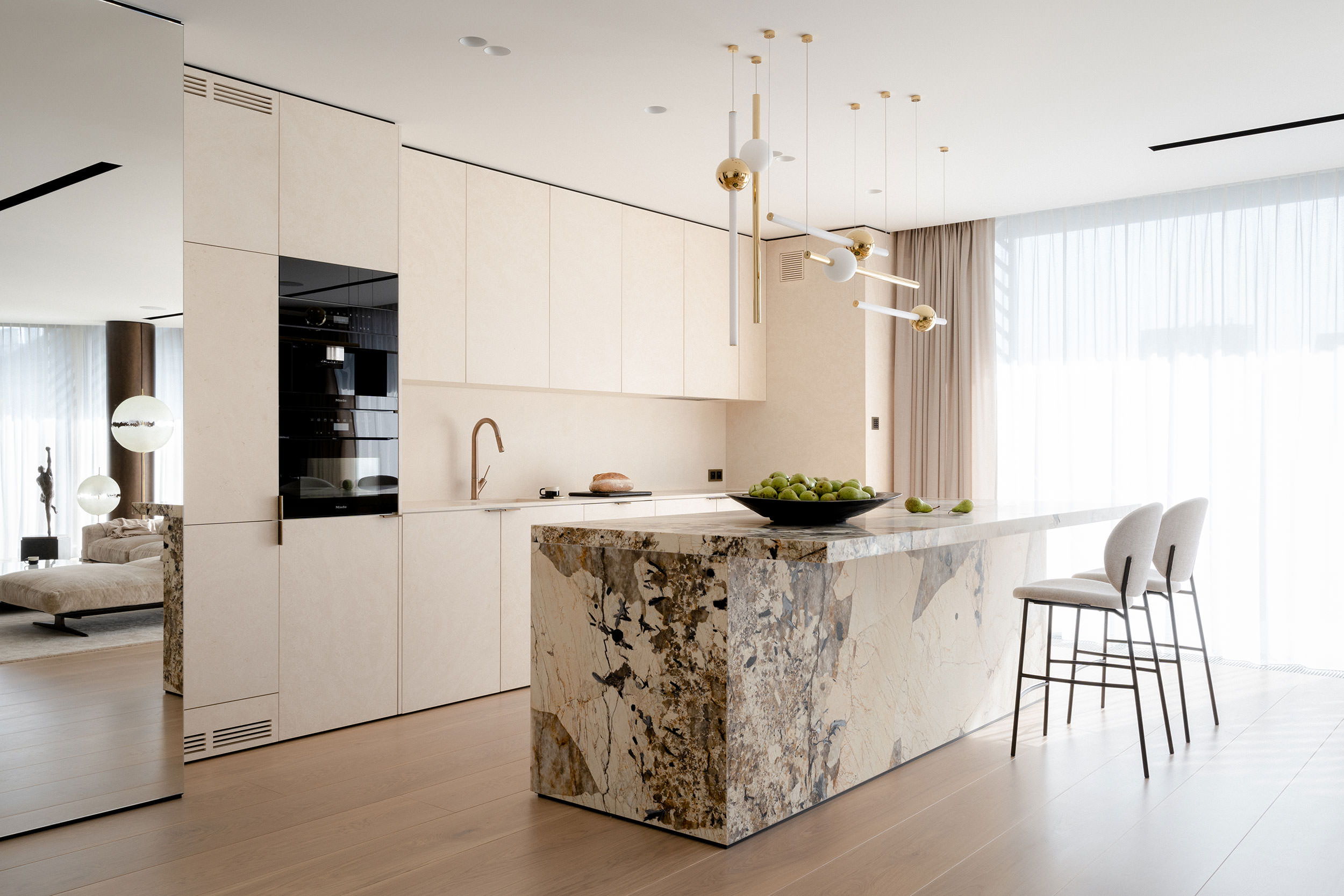
The kitchen island is a little different. In order to liven up the minimalist décor a little, the designers proposed a stone with a clear, dominant grain – the same as in the entrance to the flat. The owner really liked the Brazilian quartzite Patagonia with its abstract drawing of unique patterns and colours, which gain in intensity depending on the lighting. The creamy beige base interspersed with silvery-black veining makes an incredible impression. It has been made into an entire island – the wide top has been extended from the living room side so that one can sit comfortably at it. In this area, the entire composition is complemented and unified by the architects’ own composition of pendant luminaires from British decorative lighting star Lee Broom. These lamps have two faces – during the day they simply please the eye with their noble form, but play the main violin at night, when they lightly smoulder and cut through the darkness like futuristic lightsabres
Zen relaxation
Behind the brass bookcase, the owners’ bedroom was designed with a private master bathroom. The investors wanted this intimate relaxation area to feel like a luxury hotel. The interior is very light and subdued
A wallpaper made of natural cotton fibres was laid on the central wall. It has a fine texture that can be felt under the hand and is incredibly soft to the touch. It is backed by a comfortable bed from the Italian brand Minotti with an upholstered headboard. – We were able to convince the owner of the lighter form, although he initially opted for a continental bed, the architects say. This looks much more subtle and does not dominate the space so much. Nightstands stand on either side, above which hang Flos lamps, finished in polished brass. The wallpaper wall is joined by a mirror, on which a suspended top with drawers has been mounted. This minimalist type of dressing table was very much to the client’s liking – specialised LED lighting has been installed around it, allowing for precise make-up
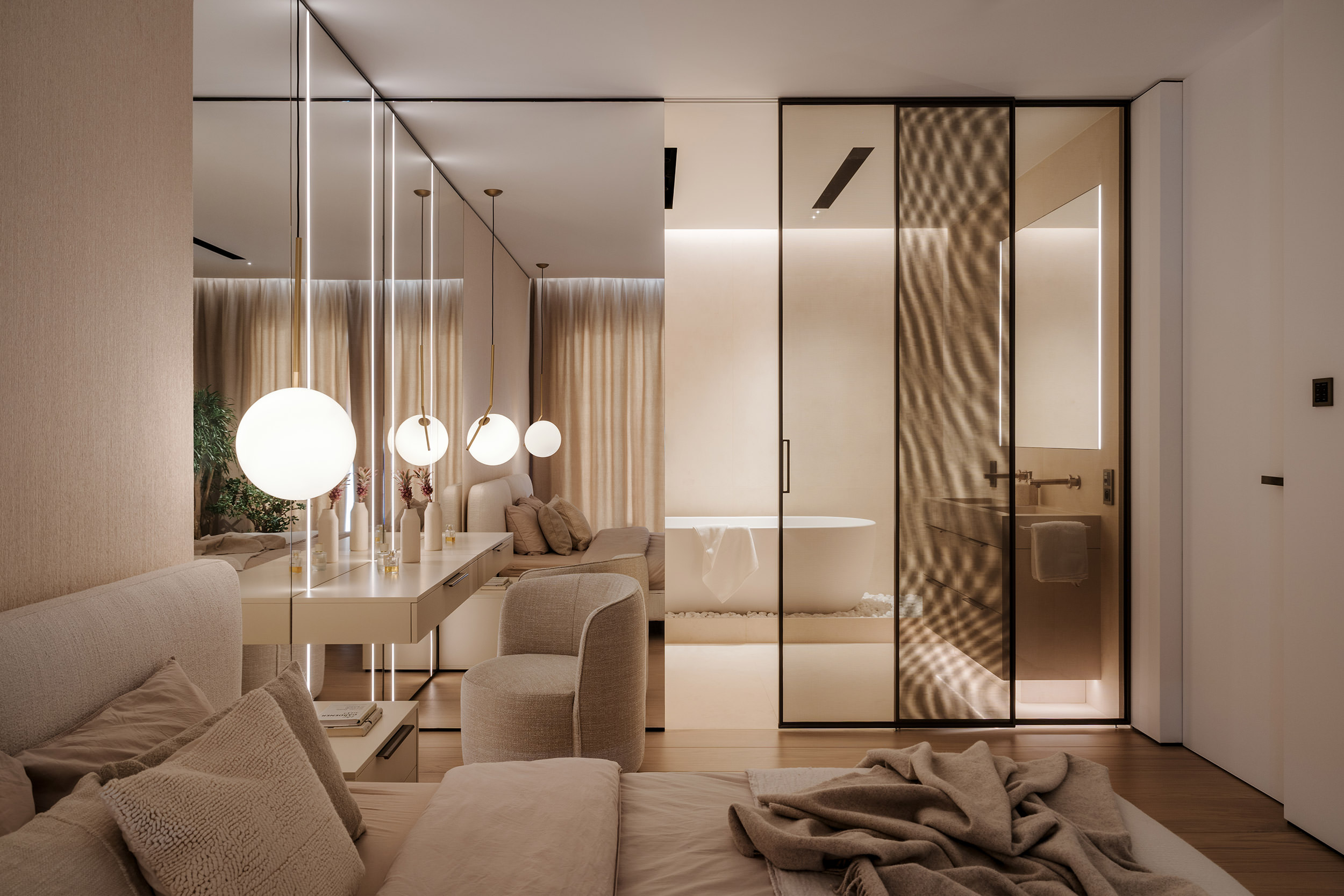
In the bedroom, as in the living room, oak, gently whitewashed planks of unusual width and length were used on the floor. They are all 30 cm wide and up to 8 metres long. Transporting them to the 3rd floor was a logistical undertaking. A mountaineering company was even hired, whose plan of action was thwarted by the weather. In the end, they were hoisted upstairs by crane
The bedroom is optically enlarged by the adjoining bathroom. It is symbolically separated from the sleeping area by a glass wall with one fixed and one sliding panel. It is a system of two-layered glass – a fine mesh is mounted between the panes, which depending on the lighting changes the translucence of the glass – in natural light it shimmers delicately and becomes misty, while in artificial light it is almost translucent, slightly smoky, giving the impression of more space. This is a unique, essentially unmistakable solution from the Italian brand Rimadesio
The bathroom is a real oasis of calm. This is what the owners wanted most. The designers arranged it in a zen-like atmosphere. In the central area, a free-standing bathtub sits on small pebbles, with an intimate light bathed above it. The owner, who loves to read while bathing, dreamed up lighting that would spotlight her reading but would not disturb the atmosphere of peace and relaxation. The entire room, with the exception of the ceiling, was finished in limestone – the same used in the kitchen. The washbasins were also made from it – with a honed (i.e. matt) finish on the outside, revealing the porous structure of the stone, while the inside was gently polished due to the material’s absorbency. The same semi-polished treatment was used on the floor. The mixers from the AXOR Uno collection in the colour of the patinated brass effect were the perfect match for the subdued design. They are very practical – they start the water by pressing the tip of the spout (which makes them easier to clean), and the temperature is regulated by a knob on the wall
This unique project would never have succeeded if it were not for the trust the client placed in the architects, but also for the designers’ great faith that what seems impossible can be realised. Such bold and unique solutions will certainly be recognised in the architectural field, but they have already received the greatest reward. – When the clients first entered the flat, they were unable to hide their emotions,” say the architects from KANDO. – That’s when we felt that we had met their expectations – the second house certainly came as a surprise and pleasantly surprisedthem
Studio: KANDO ARCHITECTS
Project authors: Kinga Klietz-Łęska, Karolina Krawczyk, Tymek Łęski
Photography: Nate Cook
_
About the studio
KANDO ARCHITECTS is a studio based in Warsaw. In their work, the architects design modern interiors in which every detail matters. Their design spaces are filled with natural, high-quality materials. They specialise in designing private interiors in the premium real estate sector. The entire design process is accompanied by an elaborate path, the first step of which is a thorough analysis of the client’s needs. – We create thought-provoking interiors that inspire and sensitise,” the designers say of themselves. Today, Kando Architects includes Kinga Klietz-Łęska, Karolina Krawczyk, and Tymek Łęski
Read also: Apartment | Interiors | Apartment | Art Deco | Warsaw | whiteMAD on Instagram

